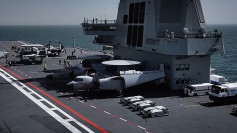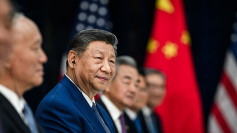China has formally commissioned the Fujian, its most advanced aircraft carrier and the first to be entirely designed and built domestically, marking a significant milestone in Beijing's effort to expand its naval reach in the Pacific. The launch comes as China continues to challenge U.S. influence in contested waters stretching from the South China Sea to the Taiwan Strait.
The Fujian, China's third aircraft carrier, entered service in a ceremony on Hainan island presided over by Chinese leader Xi Jinping. Chinese state broadcaster CCTV said more than 2,000 naval personnel and shipbuilders attended the commissioning. The ship features an electromagnetic catapult system, the same advanced technology used on the U.S. Navy's USS Gerald R. Ford, allowing aircraft to launch with heavier fuel and weapons loads than those deployed on China's older, ski-jump carriers.
The new system marks a shift from China's first carrier, the Liaoning, acquired from the former Soviet Union, and the Shandong, which was built in China based on the same design. The Fujian represents a full new generation of Chinese naval engineering, including catapult positions that support aircraft such as the J-35 stealth fighter, the J-15T heavy-fighter variant, and the KJ-600 airborne early-warning aircraft.
The Pentagon still views the U.S. fleet as technologically superior, with 11 aircraft carriers-each nuclear-powered-providing virtually unlimited operational range. By contrast, the Fujian is conventionally powered and is estimated to travel 8,000 to 10,000 nautical miles before refueling. Analysts say this leaves China reliant on port access and logistical support in far-sea operations, though Beijing is believed to be developing a nuclear-powered carrier.
The Fujian adds capacity intended to support China's long-stated goal of modernizing its military to be "basically complete" by 2035 and "world class" by 2049. The carrier is widely viewed as central to China's planning for a potential conflict over Taiwan, which Beijing claims as its territory.
Neighboring governments have signaled concern. Japan's top government spokesperson, Minoru Kihara, said, "It appears that the aim of the Chinese military is to enhance its operational capabilities in distant waters and airspace through the strengthening of their naval forces." He added that China was "expanding its military capabilities extensively and rapidly, without sufficient transparency," and stated that Japan would "respond calmly but also resolutely" if regional stability is threatened.
The Fujian is only the second carrier in the world equipped with electromagnetic launch technology after the USS Gerald R. Ford. However, it remains smaller, with experts estimating capacity for 40 to 60 aircraft, compared to the Ford-class carriers' 60 to 70. The Fujian also uses two aircraft elevators, while the Ford class includes three, enabling faster launch cycles.






